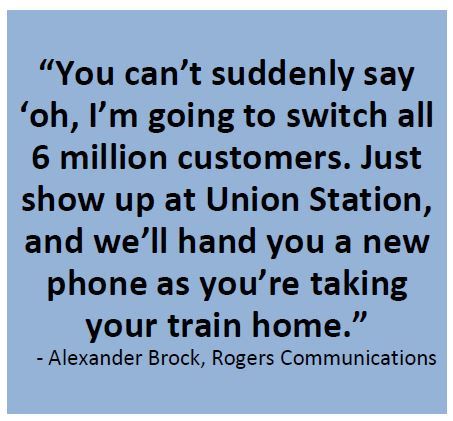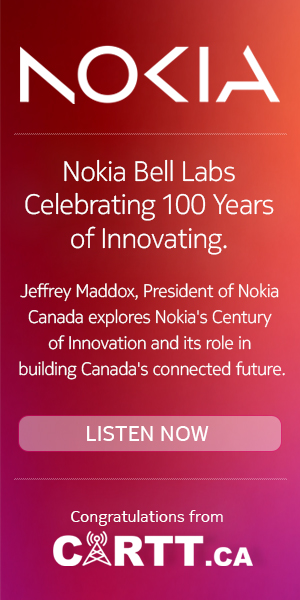
AMID THE SWIRLING STORM surrounding the impending 700 MHz spectrum auction, a certain fact is often cited – followed closely by often obtuse, naïve assumptions which have served to warp the spectrum debate.
The fact we’re talking about is how Rogers, Bell and Telus own 85% of the existing spectrum licensed for wireless services in Canada. It’s a big number. It’s the correct number. When you put it in a pie chart (as the Industry Canada web site has), it looks daunting and very important. However, those who use that number to say the big three now have “enough” spectrum, that they don’t need any more and should be able to make do with their current lot of spectrum and repurpose it for the exploding growth in data consumption fueled by their customers, are either foolish or skirting wireless market realities.
While LTE is the newest, best thing now and is growing fast, most of the devices running on the wireless networks of Rogers, Telus and Bell are 2G or 3G devices, not 4G (for competitive reasons, they don’t break down the actual numbers). Those millions of Canadians are currently using the 85% of the spectrum that was either allocated or auctioned to the big three over the years. These people can’t be “repurposed” to other spectrum without enormous expense for their carriers and serious disruption to their wireless services. Devices would either be significantly downgraded in usability or rendered inoperable. Not great for customer service.
Rogers, for example, actually runs three networks to serve its nearly 10 million Canadian customers, a GSM network, an HSPA network and its newest, LTE network. “LTE has only been up and running for a relatively short period of time, so yes, the good news is people like it and are adopting it, but there’s still a long transition period going to happen, where people have devices and keep them for a good length of time. So if you’ve got an iPhone 4 or an iPhone 3, you’re on HSPA. Unless you want to buy an iPhone 5 or better, you’re going to be on our 3G network for a good while,” Rogers vice-president of emerging technologies and innovation Alexander Brock told Cartt.ca in an interview.
While the Canadian incumbents have shut down older networks, transitioning people first from analog and then from TDMA, for example, in order to reclaim and repurpose bandwidth, that step is only taken when there are just a few thousand people left using those frequencies. They are typically given new phones by their carrier.
“We can’t force customers (off a network). It’s important to realize that we have managed this migration now over 25 years. We started in analog. We migrated to TDMA. We migrated off of TDMA to GSM. We’ve migrated from GSM to GSM and HSPA. Now, we’ve LTE on it. This happens all the time. It’s happening in the U.S. You’ve got Verizon, who owns both 850 MHz and 700, and AT&T, who owns both 850 and 700. They have the same migration challenges that we do,” Brock continued.
“You can’t just suddenly say ‘oh, I wish it was so; I’m going to move all the customers off and re-purpose.’ Life is not like that. We have customers who bought their devices, and we know approximately how long it takes for the migration to happen. We do a lot of that on the basis of what do we sell in market, so right now, are we selling GSM? No, we’re not putting any more GSM on. Are we selling HSPA devices? Of course we are because anybody who’s in the GSM community is selling HSPA and LTE. Are we selling more LTE devices than ever before? Absolutely.
“But the point is it’s a migration that’s driven by devices and how long customers keep them. When the last X number of thousand is left, you have so few customers that the bandwidth can be re-claimed. But until you’ve got it down to a manageable number, you can’t suddenly say ‘oh, I’m going to switch all 6 million customers. Just show up at Union Station, and we’ll hand you a new phone as you’re taking your train home.”

LET’S LOOK AT ROGERS’ 850 MHz spectrum as an example. The company has 25 MHz worth of 850, 15 on GSM and 10 on HSPA. The 10 MHz is totally off the table because of the millions of devices currently using it. If that spectrum was suddenly taken away, the devices either wouldn’t work or would drop down to Edge or GPRS and data speeds would be abysmal.
So, that leaves 15 MHz at 850 left. Because of machine to machine communications and the fact Rogers is still the lone GSM network in Canada for visitors to roam on, the company believes it will have to leave 5 MHz of GSM for a very long time. So, that leaves two 5 MHz blocks of 850 MHz on GSM that could be converted to LTE. Sounds good, right? Not quite, says Brock.
“Wireless is all about ecosystems… and it takes a significant amount of time from when you deploy and the time where everybody has got and jumped on that ecosystem,” he adds. “One of the things it’s important to realize is that not all bands appear in all devices at the same time. Today you can count on one hand how many devices actually have the 850 MHz band in LTE in the device. You can’t say ‘just convert it all and everything will be fine’ because you’ve got to convert 2G, 3G and your existing base of 4G customers, as well.”
And it’s not as though the carriers don’t want to repurpose the bandwidth. They just have to be as patient as possible. “The amount of bandwidth being used per customer is going up exponentially, so the reclaiming of the bandwidth is essential,” added Brock. “Whether you’re AT&T or Verizon or T-Mobile or ourselves or Bell or Telus, everybody is going to be reclaiming that spectrum, over time to create the bandwidth… the technology, in terms of number of bits for each number of hertz that you get, is not keeping pace with demand. The argument that you can artificially make it by creating cell sites is a false one because A) you couldn’t create that many sites and actually make it a habitable place to live because you’d have them on every lamp post; and B) you couldn’t haul the traffic back – it’s just uneconomic to do so.”
Plus, with Verizon and AT&T controlling the wireless ecosystem in North America and widely deploying 700 MHz for their LTE launches, it’s imperative Canadian carriers gain access to the same spectrum says, well, every single Canadian carrier. “As you know, Verizon has the upper 700 MHz band, and AT&T has the lower 700 MHz band, so their device ecosystems, even though they’re both doing LTE, are not the same. Their timelines are different and their transition and adoption of different bands actually happens at different times,” explained Brock. “Let’s not put too fine a point on it: They control when stuff happens and what shows up in what devices by volume, so the reality is there’s a very complex set of what-if statements that you get saying okay, ‘if you’re in one ecosystem, you can have the following bands’.”
THIS NEXT AUCTION COMING up isn’t just more spectrum, it’s “must-have”, low frequency spectrum that travels long distances – making it excellent for rural deployments – and penetrates obstacles – meaning it’s great for in-building use. But the higher frequency spectrum, which travels shorter distances, is higher capacity. That means all wireless companies need access to low and high frequency spectrum – and is part of the reason why Industry Canada wants to make sure companies other than the big three get their hands on 700 MHz and has said Rogers, Bell and Telus may buy just one block each.
Despite the fact Verizon has renounced its interest in the Canadian marketplace, the big three carriers are still worried about the potential of being shut out of access to 700 and are angry with the way Federal Industry Minister James Moore has characterized them as having enough spectrum or hoarding it.
As for those who claim Canadian carriers are not using their spectrum in an efficient way? Well, that’s just more naïve analysis. Sure, Canada’s MHz/pop is well behind the U.S. – a country with 10 times the population and hundreds more cities. The big three say their spectral efficiency in big cities are on par or better with their peers in American cities (but those numbers are not available to the public). Spread over out our geography, where there are an average of 3.75 people per square kilometre, compared to 34 people per square km in the U.S., spectral efficiency looks bad. But it’s not as though any company can take what might be underutilized spectrum in Kapuskasing and transport it to Toronto.
Spectrum just doesn’t work that way. It’s far, far more complicated than what can be summed up in a pithy sound bite.



